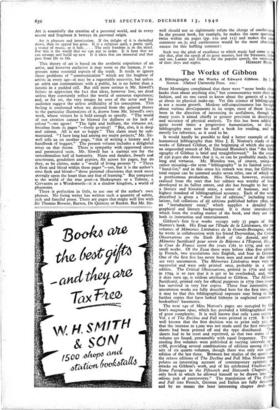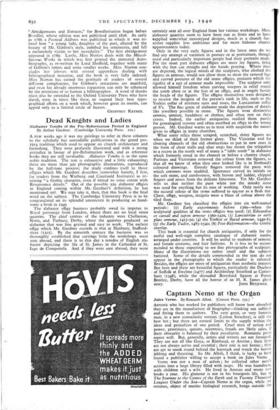The Works of Gibbon
A Bibliography of the Works of Edward Gibbon. By Norton. (Oxford University Press. 215.)
EVEN Montaigne complained that there were "more books abo books than about anything else," but commentaries were then fashion, and no one cared to know about the genesis of a or about its physical make-up. Yet this science of bibliograp is not a recent growth. Modern self-consciousness has broug about various deve:opments in its scope, most of these hay been in the direction of increasing its usefulness, though f many years it aimed chiefly at greater precision in descripti and accuracy of physical analysis. To this has been added quite recent times a progressive humanisation, so that bibliography may now be itself a book for reading, and n merely for reference, as it used to be.
It would hardly be possible to find a better example of humanised bibliography than Miss J. E. Norton's study of works of Edward Gibbon at the beginning of which she quot an unguarded remark of Mr. Edmund Blunden's that "the bib ography of Gibbon is brief and straightforward." In the cour of 256 pages she shows that it is, or can be profitably made, ho long and tortuOUs. Mr. Blunden was, of course, using rather misusing—the term " bibliography " in its limited sense "hand-list," and in this sense his remark was true, for Gibbo total output can be summed under seven titles, one of which w a posthumous production. Miss Norton, however, evident realised from the start that her subject was worthy of bei developed to its fullest extent, and she has brought to her ta a literary and historical sense, a sense of humour, and t highest standard of bibliographical accuracy. Each of the woe described is given a "short list of editions," including tam lations, full collations of all editions published before 1800, an "introductory essay," which supplies a detailed bi graphical and literary background. It is these introductio which form the reading matter of the book, and they are n both in instruction and entertainment.
Gibbon's first fo ir works occupy only 35 pages of M. Norton's book. His Essai stir PEtude de la Litterature, the t volumes of Memories Litteraires de la Grande-Bretagne, whi he wrote in collaboration with his friend Deyverdun, the Critt Observations on the Sixth Book of the Aeneid, and Memoire lustificatif pour servir de Reponse a PExpose, &c., la Cour de France cover the years 1761 to 1779, and are small works. Of the Essai there were before i8o0 five editio in French, two translations into English, and four in Genn One of the first five has never been seen and most of the oth are very uncommon. The Memories Litteraires were very successful and were only printed once, probably in a sm edition. The Critical Observations, printed in 1770 and aga in 1794, is so rare that it is apt to be overlooked, and, wh it does turn up, is seldom attributed to Gibbon. The Minim Yustificatif, printed only for official purposes in 1779 (two issue has survived in very few copies. These four interesting a uncommon works are fully described here for the first time, it may be that this bibliographical exposure may bring to lag further copies that have lurked hitherto in neglected corners booksellers' basements.
The next 140 of Miss Norton's pages are occupied by GI bon's magnum opus, which has provided a bibliographical stu of great complexity. It is well known that only ',coo copies Vol. of The Decline and Fall were printed in 1776. It is 1 well known that the first decision was to print only 500, that the increase to tpoo was not made until the first twenty- sheets- had been printed off and the type distributed. Tile sheets had to be reset and reprinted, so that two states of r volume are found, presumably with equal frequency. The su ceecling five volumes were published it varying intervals up 1788, providing several combinations of editions among the sets of six quarto volumes, though there was only one qu edition of the last three. Between her studies of the quarto the octavo editions of The Decline and Fall Miss Norton int polates an interesting account of contemporary opinions attacks on Gibbon's work, and of his celebrated Vindicator' Some Passages in the Fifteenth and Sixteenth Chapters,. only book in which he allowed himself to be drawn into odious task of controversy." The translations of The Dec and Fall into French, German and Italian are fully descri and by no means the least interesting chapter deals "Abridgements and Extracts," for Bowdlerisation began before Bowdler, whose edition was not published until 1826. As early as 1786 a Poetical Address was published in which it was re- lated how "a young lady, daughter of the poet, allured by the beauty of Mr. Gibbon's style, imbibed his sentiments, and fell a melancholy victim to her incredulity." The first abridgement appeared in 1789. Lastly, Miss Norton deals with the Miscel- laneous Works in which was first printed the immortal Auto- biography, as re-written by Lord Sheffield, together with many of Gibbon's letters and some smaller works. Miss Norton con- cludes her labours with several appendices dealing with bibliographical minutiae, and the book is very fully indexed. Miss Norton has earned the gratitude of readers of several different complexions, for Gibbon's attractions are manifold, and even his already enormous reputation can only be enhanced by the attentions of so human a bibliographer. A word of thanks must also be extended to the Oxford University Press who have dared, even in times like these, to expend their best typo- graphical efforts on a work which, however great its merits, can appeal only to a limited circle of buyers.
GEOFFREY KEYNES.











































 Previous page
Previous page